Table of Contents
What is Resistance?
Resistance is defined as the property of a substance that opposes the flow of electrons or electric current through it.
*Resistance absorbs the electric current and generates it into the form of heat.
For Example, if we put a charger for a long time and touch it, we find that it produces heat, that heat was generated by the resistance. Resistance defined by a law called “OHM’s Law”. The SI unit of resistance is ohm, the symbol of ohm is Ω.
OHM’S LAW
Ohm’s Law states that “If a conductor does not change its physical quantity like temperature, pressure, etc. So the current flowing between two points of the conductor will be directly proportional to the potential difference (voltage) between them ”.
Where, R= Resistance
V= Voltage and I= current
NOTE:- Ohm’s law given by a scientist “Georg Simon ohm in 1827”.
How to calculate resistance?
There are so many ways to calculate resistance for example by multimeter, megger meter, etc. But if you have to calculate the value of resistance manually then you should know the colour coding, colour bands and the meaning of each band on resistance.
So, now we have a table which is showing the value of each band of resistance.
Check here for the calculation of any value of resistor
A handy tool for reading resistance, click here
HOW TO READ RESISTOR CODES?
In these sections, some examples are given for a different number of bands, but here some tips are given to read the colour code:
- The direction of reading might not always be clear. Sometimes the more space given between band 3 and 4 gives the reading direction. Usually, the first band is close to lead. Gold, silver or no colour band (the tolerance) is always the last band.
- It is better to measure the resistance with a multi-meter. In some cases this is the only way to find out the resistance’s value; for example, If the colour bands are burnt off and get damaged.
4 BAND RESISTOR
The four colour code band is the most common resistance. These resistors have the first two bands for the resistance value, the third band is for multiplier and the last is tolerance band. As shown in the given figure these bands are green, blue, red and golden. By the use of colour code chart, the first band is green which stands for 5, the second band is blue which stands for 6 and the third band is red which stands for 2 which is the multiplier. The value of resistance is 56×100 =5600 Ω. The golden band shows that the tolerance of the resistor is 5%. Now the total resistance value is between 5320 and 5880 Ω.
If the fourth or tolerance band would be blank, then the result will be of 3 colour band resistor. So that the resistance value will be the same, but the tolerance value becomes 20%.
5 BAND RESISTOR
Some Resistors are with high precision have an extra band to show a third significant digit. These resistors have the first three bands for the resistance value, the fourth band is the multiplier and the fifth band represents the tolerance of the resistor. There are some exceptions in this case. Like for example, in some cases, the extra band indicates failure rate or temperature coefficient. Please go through the section ‘Colour code exceptions’ for more Details.
As shown in the figure: brown colour stands for 1, yellow colour stands for 4, Violet colour stands for 7, black colour is of the multiplier (x1), green Stands for temperature coefficient (0.5%). Now the total value of resistance is 147 Ω 0.5%.
6 BAND RESISTOR
Resistors with 6 bands usually show the high precision value resistors that have an additional band to express the temperature coefficient (ppm/K). The most likely used colour for the sixth band is brown (100 ppm/K). This statement says that for a temperature change of 10 ˚C, the resistance value can changed by 0.1%. For example:
As shown in the figure: orange band stands for 3, the red band stands for 2, the brown band stands for 1, brown stands for multiplier (x10), green stands for tolerance of resistor (0.5%), red Stands for the temperature coefficient (50 ppm/K). Now the total value of resistance is 3.21 k Ω 0.5% 50 ppm/K.
COLOR CODE EXCEPTIONS
Reliability band For temperature coefficient
Those Resistors which are produced for the military specifications, usually having an extra band to indicate the reliability of the resistor. This indicates the failure rate (%) per thousand (1000) hours of service. These resistors are rarely used in commercial electronics.
RESISTANCE HAVING SINGLE BLACK BAND OR ZERO-OHM RESISTOR
A resistor having a single black colour band is called a zero-ohm resistor. According to its work, this is a wire link with just to function of connecting traces on a Printed circuit board (PCB).
5 BAND RESISTORS WITH A 4TH BAND OF TOLERANCE
5 band resistors with the 4th band of tolerance (gold or silver) form an exception and are used on special and older resistors. The first two Colour bands represent the resistance value, the 3rd for multiplier factor, the 4th is for tolerance and the 5th for temperature coefficient (ppm/K).
DEVIATING COLORS
For the value of high voltage, In resistors, the colours silver and golden are replaced with gray and yellow. These resistors are used to prevent having metal particles in the coating.
Let's discuss some questions
Question 1. Which wire is having more resistance and why?
Answer. Resistance is directly proportional to the length and inversely proportional to the area of the conductor. So, the wire which is having less area will be having more resistance and the wire of large area will be having less resistance.
Where R=resistance
A= area of the wire or conductor
Question. What is the formula of resistance?
Answer. Resistance represents by R. The formula of resistance is shown below
Where R=resistance
V= voltage and I=current
Question. What is the SI unit of resistance?
Answer. The unit of resistance is ohm and the symbol of ohm is Ω.
Question. If a circuit is having a voltage of 230V and current of 5A then what is the value of resistance in a circuit?
Answer. R=V/I
R=(230/5) Ω
*For more information please drop your question and query below in comment box*.

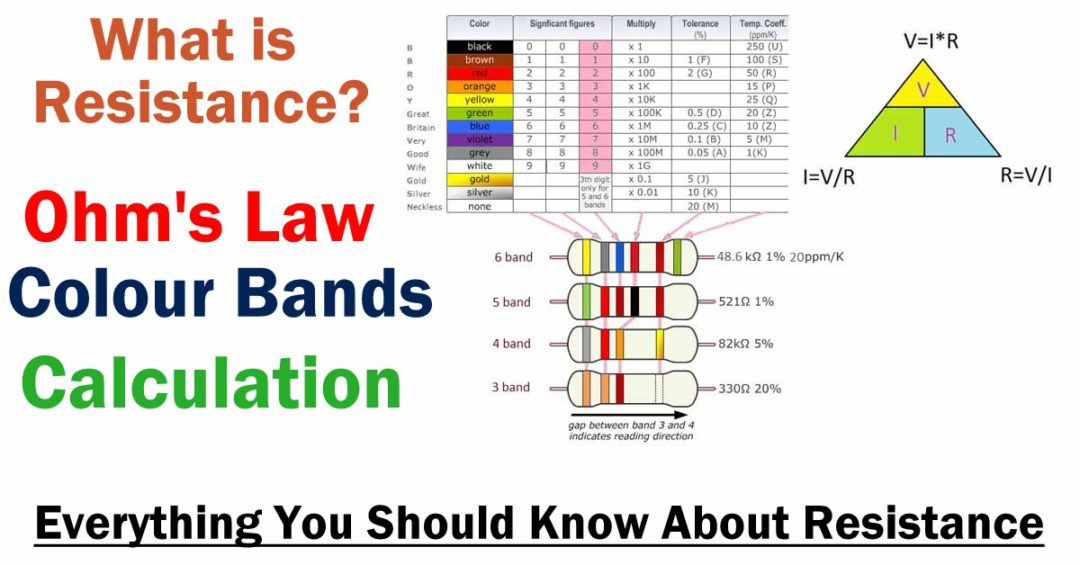
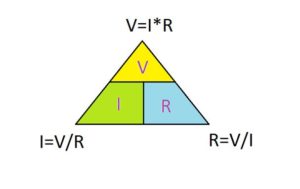
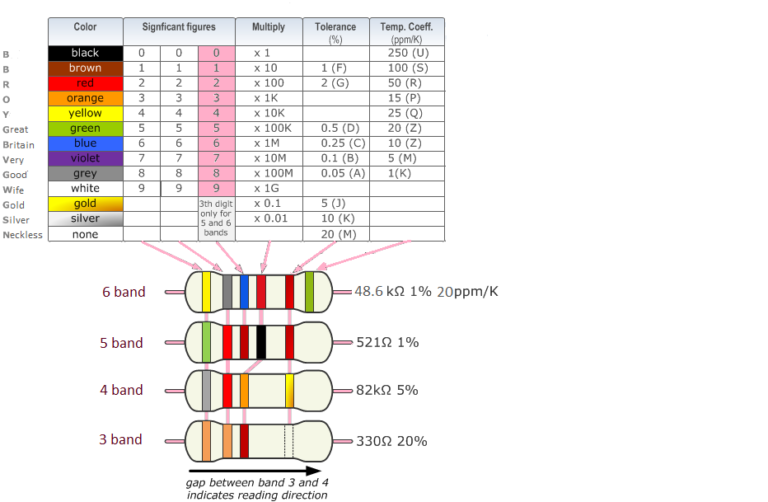
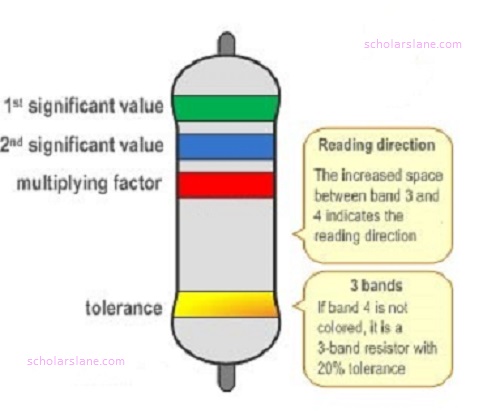
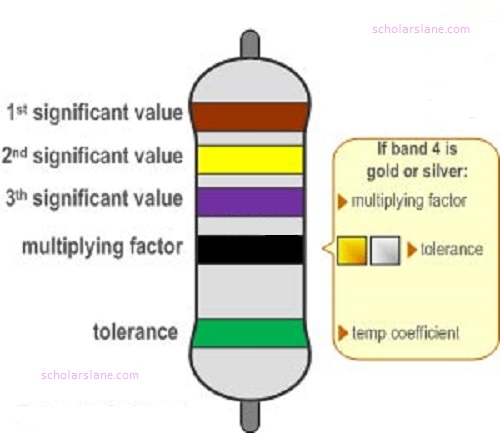
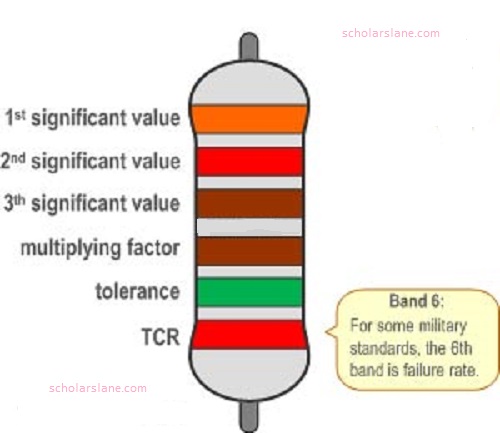
2 thoughts on “What is Resistance?, Colour Code Table, Ohm’s law”